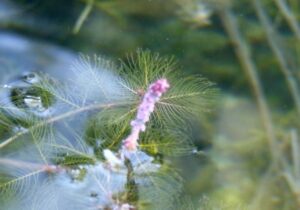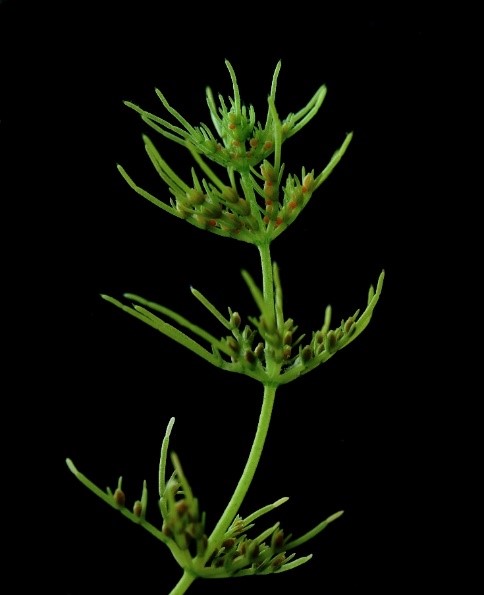Chara
algae identification
Chara is an order of green algae belonging to the class Charophyceae. These freshwater algae are commonly known as stoneworts due to the calcium carbonate deposits that often encrust their stems and branches, giving them a stony appearance. Chara are often found in clean, shallow freshwater habitats such as ponds, lakes, and slow-moving streams.
- Long stem, with cylindrical, whorled branches.
- Each node will have around 6-16 branchlets.
- Chara has no flower, and will not grow above the water’s surface.
- Grainy texture and will smell musty when crushed.
- The stem has no supportive tissue and can appear quite translucent.
- Lighter green colour than other aquatic vegetation.
- Milfoil (aquatic plant) and Hornwort (aquatic plant)
- Milfoil appears more feather-like in its whorls, and will produce flowers.
- Nitella (algae)
- Nitella are a deeper green and the branches feel smooth.

(Eurasian Water Milfoil (Mackenzie, 2016)
Chara play an important role in freshwater ecosystems. They provide food and habitat for various aquatic organisms and help to stabilise sediments. Their ability to absorb nutrients may help improve water quality.
What does Chara look like?
Disadvantages of Chara
When Chara become excessive in aquatic ecosystems, it can lead to ecological and environmental issues. They can form dense mats which outcompete various aquatic vegetation and alter the habitats for fish and other aquatic organisms. Dense growth of Chara can lead to decreased oxygen levels and create a nutrient imbalance.
treatment
Coptrol – Algaecide control designed to kill algal cells. Use on mild to severe algae blooms.
Aquatic Razer Rake – DIY Physical Removal. Ideal for mild infestations, sensitive water bodies and sensitive fish species.
prevention options
Aquatic Blue Dye – Blue dye that may reduce temperature of the water body by reducing UV light penetration. This may then increase oxygen saturation.
Phoslock – Phosphorous is the main food source for algae. By reducing the nutrient input, algae do not have enough food to replicate.
Barley Straw Bales and Barley Straw Extract – Barley Straw works to suppress the future growth of algae.
Waterbac – Beneficial Bacteria helps to reduce excess nutrients in the water body which may lead to an algal bloom.



